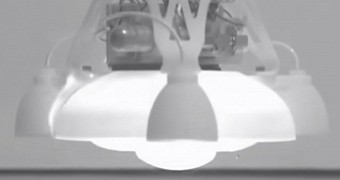Harvard and University of California have 3D-printed a tiny little robot that can jump 2.5 feet, and it's the size of a soccer ball.
Replicating the feats of frogs and locusts of jumping distances much, much larger than their actual sizes, the little 3D printed robot jumps in a way that would make Tony Stark proud. It triggers a small explosion that propels it through the air.
Having a flexible, inflatable base, the robot has to be as durable as it is powerful, and no matter how much it leaps, it has to land safely back. When preparing for a jump, the robot will inflate its legs, and afterwards it lights a mixture of butane and oxygen propelling it through the air in a controlled manner. Apparently, the robot had managed 100 successful jumps without causing itself any harm.
It seems that the resilience of the robot comes from its intelligent mixture of hard and soft materials that combine together in a smart way to alleviate the propelling and landing shocks. The success comes from adapting a gradient soft to hard materials design, eliminating the classical abrupt hard-to-soft design that always guaranteed failure in robotics.
The success of the "jumping robot" will have almost endless capabilities that could actually turn it into far more than just a jumping object but a platform for future "jumping" designs. Imagine putting these in the feet of humans and see their jumping abilities multiplying tenfold. The possibilities are literally endless.

 14 DAY TRIAL //
14 DAY TRIAL // 